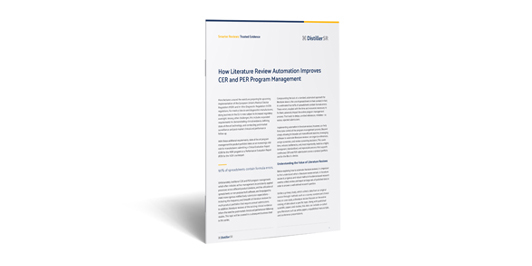Case Study
Philips Achieves Faster, More Accurate Literature Reviews for CER Submissions with DistillerSR
Philips was looking for a transparent, standardized platform for more efficient literature reviews and CER submissions. Implementing DistillerSR resulted in over 70% faster literature review screening while improving speed and accuracy for CER submissions.

Faster, More Accurate Screening
The clinical evaluation team at Philips cut down title and abstract screening by 74%, full text screening by 70%, and flowcharts/diagrams creation by 50%.

Consistent, Auditable CER Submissions

More Time to Focus on Research
Since implementing DistillerSR, Philips reported gaining 3 extra days per literature review to focus on research, rather than the mentally-burdensome task of shifting through references.
At Philips, literature reviews support every stage of the medical device lifecycle process, from concept and design to clinical trials, regulatory approval, market launch, and post-market surveillance.
The clinical evaluation team at Philips understands the importance of methodologically sound literature reviews for medical devices. In cases where it may not be feasible or ethical to test a medical device on human subjects, the research related to equivalent devices becomes the benchmark. This data is subsequently used to check for conformity with safety and performance requirements, establish the state-of-the-art (SOTA) analysis to ensure that the device is in line with current market best practices, and support a new indication for a legacy device.
Maintaining compliance with the European Union Medical Device Regulation (EU-MDR) is an ongoing process that requires manufacturers to consistently monitor for adverse events to ensure that changes to product safety and risk are appropriately captured and conveyed prior to the audit process. Many organizations find this continuous monitoring a challenge, especially in the current era of information and data overload.
Manual Literature Reviews Led to Challenges in CER Submissions and Market Readiness
Sara Garbin is a senior clinical development scientist who leads the clinical evaluations team at the Philips Sleep and Respiratory Care (SRC) unit.
Among other challenges, Sara’s team faced increasingly tight deadlines, stricter regulatory requirements, and an ever-growing volume of evidence-based research literature. When she joined the unit in 2018, literature reviews were being conducted 100% manually. They were time consuming, difficult to manage, and error prone. Add a global template requirement layer such as incorporating the PRISMA diagram into these processes and they were faced with yet another hurdle: manually counting hundreds of references. Furthermore, manual literature reviews were not scalable beyond a single submission, and their lack of transparency and audit trails meant they might not stand up to the scrutiny of notified bodies.
Sara described the process of manually conducting literature reviews: “We were putting our appraisals into spreadsheets, exporting the references from various databases into a Word document, reviewing these references and then making inclusion/exclusion comments on that same document. The process was error prone and time consuming because if you accidentally moved a reference around and the inclusion/exclusion comment didn’t get moved with it, you were suddenly left with loose comments that were not linked to a particular reference. The end result had the potential to be very messy. It was an awful exercise to do it manually. We were at the mercy of human nature: each person phrases things differently and there was no easy way to search and filter consistently, especially if we had multiple reviewers working on a single project. And this is not to mention the risk of individual bias. With DistillerSR, we now use global templates throughout our process, such as the automated PRISMA report, which saves us considerable time.”
Manual literature reviews were negatively impacting CER submissions, which translated to increased cost and delays. A transparent, standardized platform to enable faster and more accurate systematic reviews became critical.
In a Philips study of their manual literature process designed to develop a baseline for the DistillerSR pilot program, the team of medical writers reported having to redo portions of their work up to 75% of the time. Disagreements between medical writers and reviewers happened up to 50% of the time. Almost all of the medical writers reported moderate to difficult effort in keeping up with new literature, and half of them reported not utilizing automation tools. The time required to complete a literature review manually was 63.5 hours.
Four DistillerSR “super users” were selected for the pilot study. They reported a 74% time reduction in title and abstract screening and a 70% reduction in full-text screening. The DistillerSR platform enabled a standardized reviewing process and improved collaboration between reviewers and medical writers, reducing the incidence of conflicts and the time required to resolve them. Automating the inclusion/exclusion portion of the review also enabled consistency and reduced the potential for conflict, since the reasons for including or excluding a particular reference are clearly documented.
DistillerSR’s customer success and professional services teams played an important part rolling out the literature review platform, working closely with Philips to configure the solution to their internal requirements and workflows.
As a result, the Phillips team was able to generate flowcharts and diagrams within DistillerSR in half the time it took to do them manually. “Everything you need is in one screen, and the information gets compiled automatically, based on your answers for each reference. As a result, the whole process of generating a PRISMA diagram has become much easier and more accurate than being at the mercy of human nature,” said Sara.
DistillerSR also reduced the hardship of the repetitive appraisal process. According to Sara, “Going through the appraisal process manually, you don’t realize the mental burden of reviewing hundreds of references in a spreadsheet continuously. When you’re working in the DistillerSR interface, everything you need is in one screen, and the information gets compiled automatically based on your answers for each reference. As a result, the whole process has become much easier and less stressful.”
The clinical evaluation team also highlighted the availability of audit-ready records as a critical DistillerSR advantage over manual processes. “CER submissions are a complicated and lengthy process, and when auditors raise red flags, you cannot rely on Excel spreadsheets and Word documents.”
Despite an initial hesitancy, all the medical writers who tested DistillerSR stated that they would not go back to manual processes. Every new hire to the clinical evaluations team has had to adopt it, and they have been extremely pleased with both the process and the results. “We made DistillerSR the new standard for our literature reviews,” Sara concludes.”
Since incorporating DistillerSR into their literature review process, the clinical evaluation team is now saving three working days per literature review, which means they are able to focus on research rather than the repetitive, burdensome process of sifting through references.
There are currently over thirty DistillerSR users spread across the image-guided therapy devices, ultrasound, diagnostic imaging, and sleep and respiratory care business groups — and this number is set to double in 2022 as Sara looks to leverage DistillerSR’s AI-enabled functionalities. “We are looking at DistillerSR’S automated reference screening, where the AI automatically excludes references based on learned behavior, to streamline the inclusion and exclusion process even more. We expect this functionality to further simplify processes and increase cost savings.”
Download the PDF version of this case study
Related Resources

Business Brief
Automated literature reviews provide greater levels of auditability and program management to CER and PER submissions.

Case Study
Dr. Bonnie H. Weiner describes the way DistillerSR reduced the time it took to complete CER literature reviews by approximately 30%.
Learn More About DistillerSR





